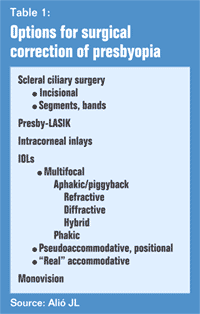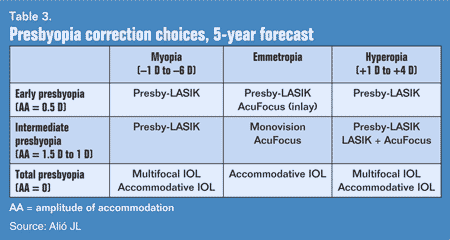Presbyopia-correcting surgery: What, when and where to do it
While there is no physiologic cure for presbyopia, new technologies and techniques bring us closer to presbyopia correction.
 Jorge L. Alió |
Presbyopia is defined as a progressive decay in accommodation related to the physiological aging process of the eye. To recover accommodation physiologically, we would need to restore the capability of the natural lens to increase its optical power relative to ciliary body contraction to focus vision for near. At the moment, we still are far away from attaining this physiological solution for presbyopia.
Rather than a physiological solution, we currently use surgical methods to improve near vision performance, using either corneal or intraocular optics to increase our depth of field. The questions that the surgeon has today, when considering the many options that are becoming available for the patient, are the following:
- What do we have now?
- What is in the pipeline?
- What is the best choice now and in the immediate future for my patient?
In Table 1, we show a summary of the alternatives we have today for the surgical correction of presbyopia.
Scleral surgery may recover about 1 D of accommodative amplitude and may be useful for early presbyopes. The results to date show that variability and regression may occur.
 |
Presby-LASIK
Presby-LASIK is a group of LASIK techniques that aim to increase depth of field in presbyopic eyes by creating multifocality in both eyes through a central, peripheral or transitional multifocal excimer laser ablation. The results of presby-LASIK seem to be very promising, restoring up to 2 D of accommodative amplitude. The results are good in early and intermediate presbyopia, where the procedures seem to have similar refractive outcomes to multifocal IOLs. Presby-LASIK seems to be more effective in hyperopes.
Intracorneal inlays
Several devices in the category of intracorneal inlay technology are currently under investigation. These devices, inserted under a LASIK flap, aim to improve near vision performance by creating a central myopic 3-mm area or by increasing depth of focus partially using the pinhole principle.
Although the devices are still under investigation, the results seem to be promising, restoring about 2 D of accommodative amplitude. They seem to be minimally invasive and reversible and to preserve distance visual acuity.
A comparable achievement to this monocular improvement of near vision with binocular implants is not feasible today.
Multifocal IOLs
Multifocal IOLs mimic accommodation through either diffractive, refractive or hybrid lens multifocality. This requires lens surgery, although phakic presbyopic implants have proven to be feasible and effective. Currently available IOLs restore up to 3 D of accommodative amplitude. They are effective in recovering near vision, they are available in many countries, and they have passed the test of time.
Neural processing is necessary with these IOLs, and neural adaptation is sometimes unpredictable. Multifocality by definition creates multiple foci, and in doing so it creates a background of scattered light. Multifocal IOLs do not offer good vision at all distances, and in some models intermediate vision (computer vision) is not optimal.
Pseudoaccommodative IOLs
Pseudoaccommodative IOLs partially restore near vision performance by creating a mobile pseudophakic condition. Single-optic lenses can restore about 1.25 D of accommodative amplitude, while dual- optic systems seem capable of restoring up to 3 D.
These lenses are dependent on ciliary body action and therefore on a physiological mechanism that can be affected by fatigue. They might require a larger amount of accommodative amplitude restoration in order for the patient to maintain freedom from spectacle use in the long term. Some technologies, such as the Nulens, are trying for this reason to restore more than 8 D of accommodation. That lens, placed in the sulcus, uses the forces generated at the capsular-zonular diaphragm by the ciliary body. It transforms those forces into changes in the radial curvature of a silicone elastic membrane, creating a system similar to physiological accommodation.
Monovision
Finally, monovision intentionally creates a low level of myopia, usually in the nondominant eye. For this purpose, excimer laser or conductive keratoplasty are used. They create a binocular disparity in refraction, which is acceptable in moderate presbyopes with an overall patient satisfaction of 86%. Monovision is an effective, simple and accessible technique that provides good results in early and intermediate presbyopia. It decreases binocularity and stereopsis moderately.

Recommendations
In Table 2, we show the recommendations for correction of presbyopia as currently used in our practice. Monovision, presby-LASIK and multifocal IOLs are our choices depending on the myopic, emmetropic or hyperopic character of the patient and whether presbyopia is early, intermediate or total.
In Table 3, we show our forecast for the correction of presbyopia surgery over the next 5 years. Once the studies that are being conducted today internationally have finished, when intracorneal inlays become available and accommodative IOLs are finally effective in restoring more than 3 D of accommodation, we shall enrich our surgical armamentarium and serve our patients better with more alternatives.
It seems that presbyopia is nearing the moment of its solution. Millions of patients around the world will benefit from the correction of this unpleasant refractive error that makes everybody, at a given moment of their lives, spectacle- dependent for near vision. Successful clinical studies and pioneering surgeons will guide the use of these different alternatives for the correction of presbyopia.
For more information:
- Jorge L. Alió, MD, PhD, can be reached at Vissum, Instituto Oftalmológico de Alicante, Avda de Denia, s/n, 02016 Alicante, Spain; +34-965-150-025; fax: +34-965-151-501; e-mail: jlalio@vissum.com.

